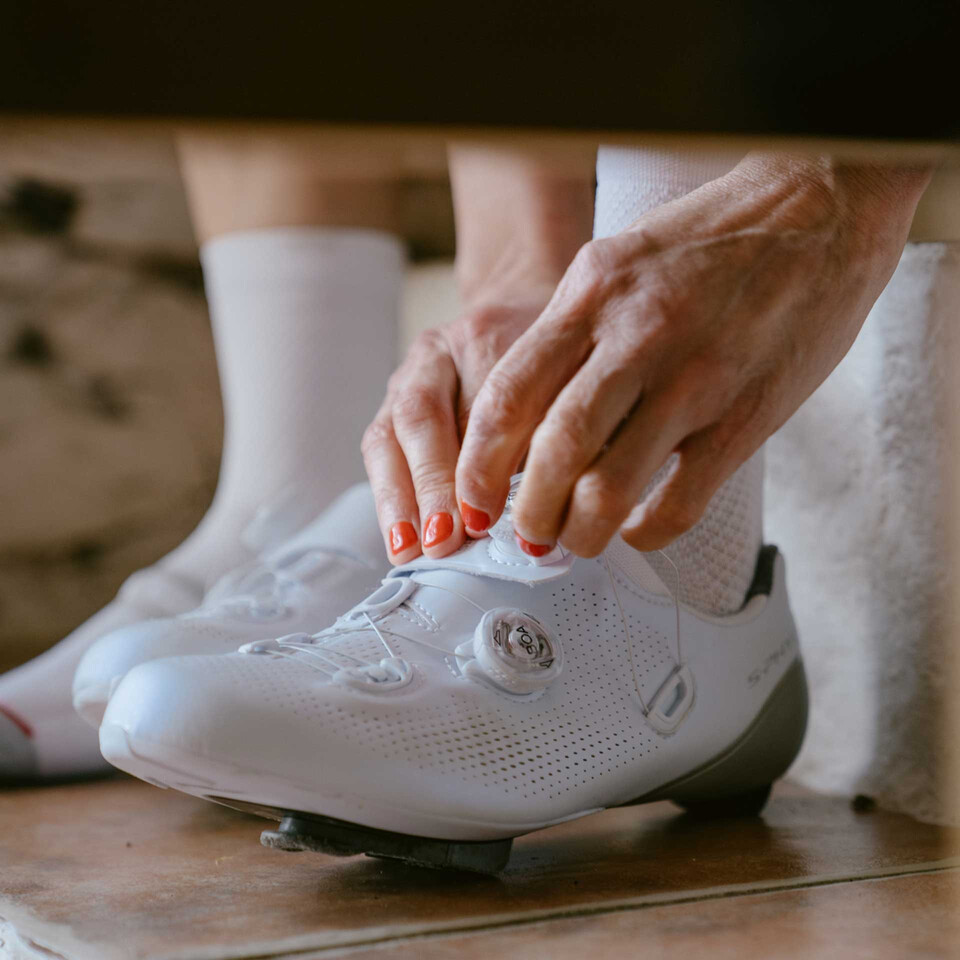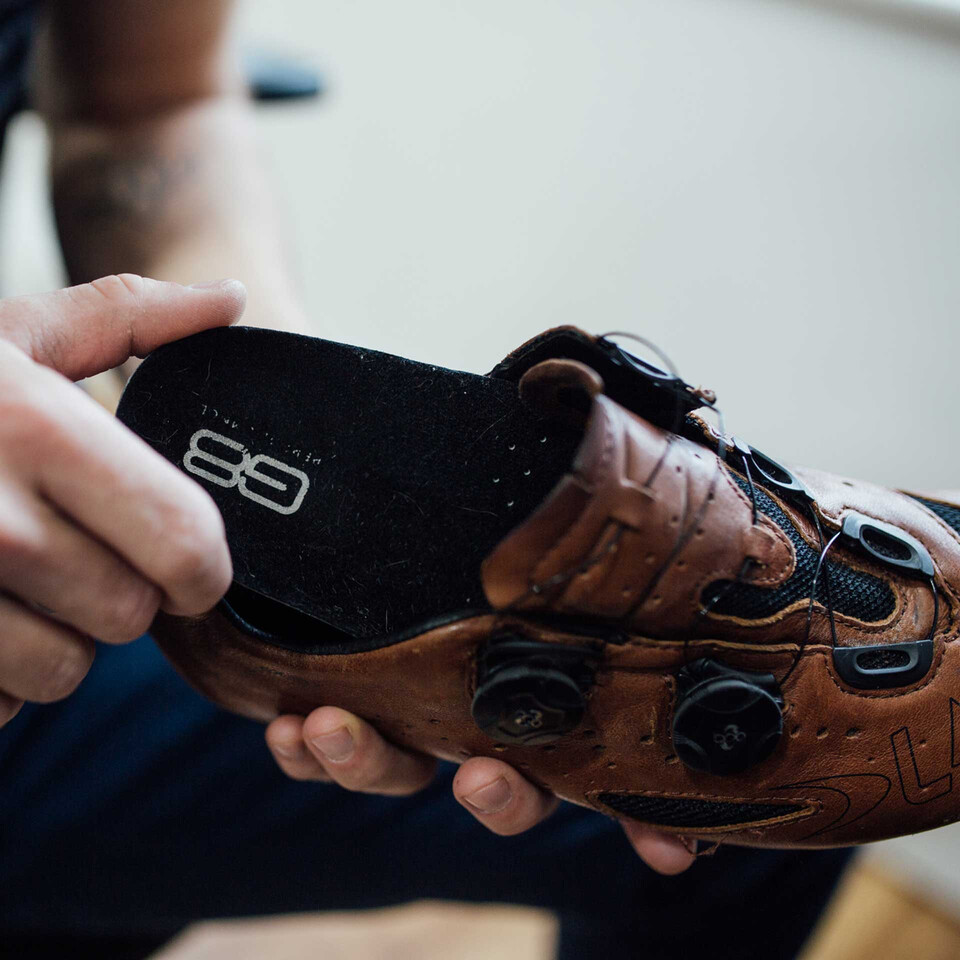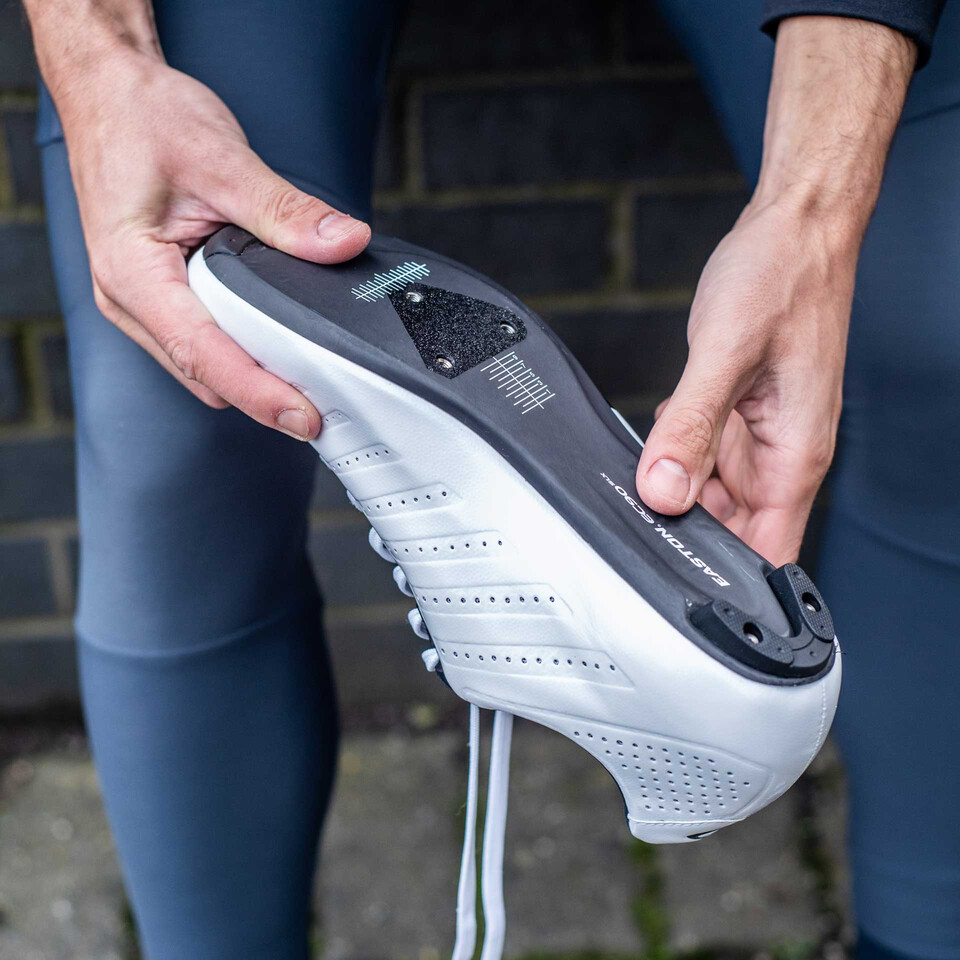
How Should Cycling Shoes Fit?
When it comes to key milestones as a cyclist one that many have reached is the purchase of cycling shoes. There are many benefits of investing in a pair of cycling shoes. Here we break down the key aspects of cycling-specific shoes and explain what you should look for when choosing a pair.

Why should I buy cycling shoes?
Cycling shoes should be considered for those looking for a more direct connection between their foot and the pedal. Unlike normal shoes such as running shoes, cycling shoes use a stiff sole, often made from Nylon or a carbon fibre blend. As well as the stiffer sole to improve power transfer, the closure system is also a feature that sets cycling shoes apart from non cycling shoes. To ensure comfort and fit is optimised brands use a range of materials and systems to ensure the foot is held comfortably and securely in the shoe. Many cycling shoes come with high quality insoles that offer interchangeable arch supports to enhance comfort and fit. The use of lightweight and breathable materials ticks a big box when it comes to performance in a wide range of conditions.

Are cycling shoes true to size?
Cycling shoes typically run true to size, although as with brands outside of the cycling industry, sizing can vary between brands and between models, with some companies offering wider options of their standard width shoes to help cater for a broader range of foot shapes and sizes. Some brands offer half sizes to ensure a more precise fit for cyclists with non-standard foot sizes. We would recommend buying a similar size shoe to the one you use day to day. The only exception to this would be winter cycling shoes, where you may want to opt to wear thicker, warmer socks and thus go up half or a whole size.
Each brand such as Lake generally have detailed sizing guides. Lake claim that over 80% found their perfect fit using their size tool, so it is worth checking these tools out when buying new footwear.

What is the difference between road and MTB shoes?
There are a number of small but important differences between road cycling shoes and mountain bike shoes. Many of these differences centre around the sole, grip and cleat compatibility. Whereas on the road the amount of time you spend with your feet on the ground is minimal, off road there are many more instances where you may have to put your foot down or get off and walk with your bike. A durable, grippy sole, therefore, is a must, as is a sole with a little more give than a road cycling shoe.
How To Measure Your Feet For Cycling Shoes
Using a three-digit millimetre measurement (e.g., 269mm) is crucial. A less precise measurement, like "26cm," doesn't provide enough detail for an optimal fit.
Step-by-Step Cycle Shoe Measurement Guide
Place a sheet of paper on a hard, flat surface. While wearing the cycling socks you normally ride in, stand on the paper, distributing your weight evenly.
Trace and Mark Your Foot: Carefully trace the outline of your foot. After tracing, use a ruler to draw lines marking the absolute furthest point on all four sides of your foot's outline. This ensures you capture the full dimensions.
Measure Your Foot Length: With a millimetre ruler, measure the longest distance from your heel to your longest toe (this could be your big toe or your second toe). For some brands such as Lake, they advise adding an additional 7mm. Once you have your measurements, refer to the specific brand's cycling shoe size chart, listed on each of our cycling shoe product pages.
Measure Your Foot Width: Use your millimetre ruler to find the widest distance across your foot, from side to side. You do not need to add any extra length to this measurement.
It's common for feet to be slightly different sizes. Repeat steps 1-4 for your other foot. When choosing your cycling shoes, you'll generally want to prioritise the size that comfortably accommodates your larger foot.
For a truly professional fit, we do recommend a trip to one of our stores where you can try various cycle shoes on and test out the fit. Alternatively, speak to our online experts for assistance.

What is the best closure system to use on cycling shoes?
There are a number of different closure options available, from a Velcro strap to ratchets, dials and even traditional laces. When it comes to choosing what closure system you need, a lot comes down to personal preference. If you plan to wear overshoes with the shoes, accessing and being able to adjust the closure system should also be taken into consideration, with a Boa dial or ratchet being easier to operate than Velcro straps or laces. A lace closure system can provide a reliable and adjustable fit, enhancing comfort and performance during rides.
Dials, laces and ratchets can also often be replaced, prolonging the life of the shoes. The type of closure system and where it is positioned on the shoe can also dictate comfort, with many manufacturers focusing on systems and positions to reduce the chances of hotspots and discomfort.

Is it worth getting clipless pedals?
If you want to get the most out of your cycling investing in cleats is a good move. Cleats vary whether you are predominantly road cycling or mountain biking and also between different brands but the concept always remains the same; to secure your foot on the pedal in the optimum position for power transfer. This attachment enhances the pedal stroke and allows you to pull up as well as push down on the pedals. The result? More power going through to the drivetrain and ultimately a faster ride.

How do you put cleats onto cycling shoes?
Attaching cleats to cycling shoes is a simple task. Cleats are usually supplied with suitable bolts. In the majority of cases an allen key or screwdriver, the size of which will be dependent on the brand of cleat, will be required to attach the cleats to the sole of your cycling shoes. Should you be looking at putting mountain bike pedal cleats onto your shoes, you may need to attach the cleat to an inner plate that sits within the shoe. Road cycling cleats on the other hand typically attach directly to the shoe’s sole. In most cases, the cleats are supplied with all the hardware you need to secure fitment.
When attaching cleats for the first time to a pair of shoes, determining where exactly to place the cleats will require a bit of thought. As a rough guide, many people opt to position the cleat under the ball of the foot but we would recommend looking at a wide range of approaches and if you really want to dial in the perfect position, consult a bike fitter who can determine the most effective location for the cleats.
Cleat adjustment is critical to ensure a comfortable and efficient ride. The cleat position should be adjusted to allow for a natural pedal stroke, with the foot firmly planted on the pedal. Most cycling shoes have adjustable cleat bolt holes, allowing for customisation to fit individual riders’ needs. Proper cleat adjustment can prevent discomfort and improve pedaling efficiency. Consult with a professional bike fitter or a local bike shop to ensure proper cleat adjustment and a secure fit, optimising your performance on the bike.

Do I need cycling insoles?
The need for cycling insoles is dependent on a number of factors, most importantly the shape of your foot and how it sits in the shoe. A cyclist may need insoles to improve support, comfort, reduce the chances of injury or to optimise their foot over the pedal. Insoles vary from out of the box products that address arch and metatarsal support to more custom offerings that moulded and personalised to your feet.
Performance focused cycling shoes often feature enhanced heel retention systems to ensure a secure and comfortable fit during rides.

What material of sole should I look for on my cycling shoes?
There are predominantly two materials used for the cycling shoe soles, Nylon and carbon fibre. These may be used exclusively or it could be made up of a mixture of the two. The differences between the two materials are stiffness and weight, with carbon fibre the more superior of the two materials. Carbon fibre soled shoes are usually more expensive than their Nylon soled counterparts but with considerable performance advantages. Sole stiffness is a crucial factor in pedaling efficiency, with stiffer soles typically found in more expensive models.
Nylon Sole vs Carbon Sole
Nylon soles offer more flexibility and comfort for walking and longer rides, making them suitable for recreational or adventure-focused gravel and mountain biking. Carbon soles are significantly stiffer, maximizing power transfer for competitive cycling and efficiency, but they are less comfortable for off-bike activities.

Upper Material
The upper material of a cycling shoe is also an important consideration. Synthetic leather upper and woven upper materials are popular choices, offering a balance of durability and breathability. Some shoes feature a velcro strap or traditional laces, while others have a boa dial or speed lace system. The upper material should provide a secure fit, with features such as a heel cup and toe box to prevent foot movement and blisters. Additionally, some shoes have custom insoles or arch support to provide additional comfort and stability. When choosing a cycling shoe, consider the upper material and features that will provide the best fit and performance for your riding style.
Cycling Shoe FAQs
What Are the Best Budget Cycling Shoes?
If you are in the market for a good pair of cycling shoes at an affordable price, then last seasons expensive shoes are often heavily discounted. These lower priced shoes from the likes of Lake, Sidi and Shimano are great for those new to the sport and looking for their first pair of road cycling shoes. These budget-friendly options often deliver exceptional performance, making them a great shoes punch for new riders.
An entry level shoe can also be found from most manufacturers such as Specialized. The base model Specialized Torch 1.0 still utilises a single Boa dial, a synthetic leather upper and a three bolt cleats system to work with most pedals.
What Are the Best Road Cycling Shoes?
As a premium bike retailer, we stock a variety of performance focused road cycling shoes perfect for riders wanting a stiff carbon sole for efficient power transfer. Top sellers include the Specialized S-Works Ares 2 as well as the high end footwear from Lake and Sidi, while the DMT shoes worn by Pogacar are also a hit. A high-quality road shoe features carbon soles, ventilation, and fit adjustments for an effective cycling experience.
What is the difference between UK and EU sizing when it comes to cycling shoes?
When buying cycling shoes, you'll often see European (EU) sizing. Here's what beginners should know:
No Universal Conversion: Unlike a direct mathematical conversion, UK to EU shoe sizes don't perfectly align. A UK size doesn't translate to a fixed EU size across all brands.
EU Sizes Are More Consistent: Most cycling shoe brands primarily use EU sizing. This is generally more granular than UK sizing, with smaller increments between sizes.
Brand Variations: Even with EU sizing, manufacturers use different "lasts" (foot molds), so a size 42 from one brand might fit differently than a size 42 from another.
The most reliable method is to measure your foot length in centimetres (cm) or millimetres (mm) and then consult the specific brand's size chart.
Any Advice For Finding the Best Cycling Shoes for Gravel?
Gravel shoes typically fall between road and mountain bike shoes in terms of stiffness. A stiffer sole (often carbon or reinforced nylon) maximises power transfer to the pedals, improving efficiency. However, very stiff soles can be uncomfortable for walking. More flexible soles (often nylon composite with rubber treads) offer better comfort and walkability, which is essential for off-bike excursions on gravel rides.
-
Snug Fit: Cycling shoes should fit snugly around your foot to minimise movement and maximise power transfer. The fit of the shoe significantly affects the efficiency of power transfer between the rider's feet and the bike. However, they shouldn’t be too tight, as your feet can swell during long rides.
-
Toe Box: Ensure you have enough room to wiggle your toes slightly. A cramped toe box can lead to numbness and discomfort.
-
Heel Cup: A secure heel cup prevents unwanted lifting, improving pedaling efficiency.
-
Arch Support: Proper arch support is crucial for comfort and preventing foot fatigue on long rides. Some shoes come with customisable insoles.
-
Boa Dials: Offer precise micro-adjustments and a secure fit that can be easily adjusted on the fly.
-
Velcro Straps: Provide quick and easy adjustment.
-
Lace up shoes: Offer a very even and comfortable fit but are difficult to adjust while riding. Ensure laces can be tucked away to prevent them from getting caught in the drivetrain.
Why Choose Sigma Sports?
At Sigma Sports we have a wide selection of road cycling shoes, gravel shoes, triathlon shoes and mountain bikes shoes from the leading brands such as Lake, Shimano, Specialized, Sidi and many more. Our range covers everything from budget cycling shoes for new riders, right through to the lightest shoes worn on the World Tour.
Whether you are in the market for a low weight, road riding shoe or a pair of winter boots we’ve got you covered. Want to get expert advice in person from your local bike shop? We are taking bookings for shoe consultations in our Hampton Wick, Letchworth and Oakham stores.





